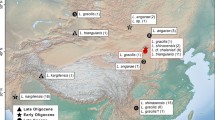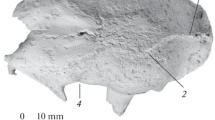Abstract
Almost 50 years after its discovery, a cranium from the early Miocene of Rusinga Island, Kenya, is designated the type specimen for a new lorisid species in the genusMioeuoticus. This new species differs fromMioeuoticus bishopi in a number of dental attributes. Several cranial features place this species in Lorisidae, where it may represent the sister group to living lorises.
Similar content being viewed by others
References
Andrews, P. 1992. Community evolution in forest habitats.J. Human Evol., 22: 423–438.
Andrews, P.;Van Couvering, J. A. H. 1975. Paleoenvironments in the East African Miocene. In:Approaches to Primate Paleobiology,Szalay,F. S. (ed.), Karger, Basel, pp. 62–103.
Charles-Dominique, P. 1976. Ecology and feeding behavior of five sympatric lorisids in Gabon. In:Prosimian Biology,Martin,R. D.;Doyle,G. A.;Walker,A. C. (eds.), Duckworth, London, pp. 131–150.
Collinson, M., 1983. Revision of East African Miocene Floras: a preliminary report.Newsletter Int. Ass. Angiosperm Palaeobot., 8: 4–10.
Drake, R. E.;Van Couvering, J. A. H.;Pickford, M. H.;Curtis, G. H. 1988. New chronology for the early Miocene mammalian faunas of Kisingiri, Western Kenya.J. Geol. Soc., 148: 479–491.
Evans, E. M. N.;Van Couvering, J. A. H.;Andrews, P. 1981. Paleoecology of Miocene sites in Western Kenya.J. Human Evol., 10: 99–116.
Gebo, D. L. 1986. Miocene Lorisids: the foot evidence.Folia Primatol., 47: 217–225.
Gebo, D. L., 1989. Postcranial adaptation and evolution in Lorisidae.Primates, 30:347–367.
Jacobs, L. L. (1981). Miocene lorisid primates from the Pakistan Siwaliks.Nature, 289:585–587.
Le Gros Clark, W. E. 1956. A Miocene lemuroid skull from East Africa. In:Fossil Mammals of Africa, No. 9, British Museum (Natural History), London.
Leakey, L. S. B. 1962. Primates. In:The Mammalian Fauna and Geomorphological Relations of the Napak Volcanics, Karamoja,Bishop,W. W. (ed.), Rec. Geol. Surv., Entebbe, Uganda, pp. 6–9.
MacPhee, R. D. E.;Jacobs, L. L. (1986).Nycticeboides simpsoni and the morphology, adaptations, and relationship of Miocene Siwalik Lorisidae. In:Contributions to Geology (Special Paper 3), Univ. of Wyoming, Wyoming, pp. 131–161.
Retallack, G. J.;Bestland, E. A.;Dugas, D. P. 1995. Miocene paleosols and habitats ofProconsul on Rusinga Island, Kenya.J. Human Evol., 29: 53–91.
Simpson, G. G. 1967. The tertiary lorisiform primates of Africa.Bull. Mus. Comp. Zool., 136: 39–61.
Walker, A. 1974. A review of the Miocene Lorisidae of East Africa. In:Prosimian Biology,Martin,R. D.;Doyle,G. A.;Walker,A. C. (eds.) Duckworth, London, pp. 435–447.
Walker, A. 1978. Prosimian primates. In:Evolution of African Mammals,Cooke,H. B. S.;Maglio,V. (eds.), Harvard Univ. Press, Cambridge, Massachusetts, pp. 90–99.
Yoder, A. D. 1997. Back to the future: a synthesis of Strepsirhine systematics.Evol. Anthropol., 6: 11–22.
Author information
Authors and Affiliations
About this article
Cite this article
Phillips, E.M., Walker, A. A new species of fossil lorisid from the miocene of east africa. Primates 41, 367–372 (2000). https://doi.org/10.1007/BF02557647
Received:
Accepted:
Issue Date:
DOI: https://doi.org/10.1007/BF02557647




